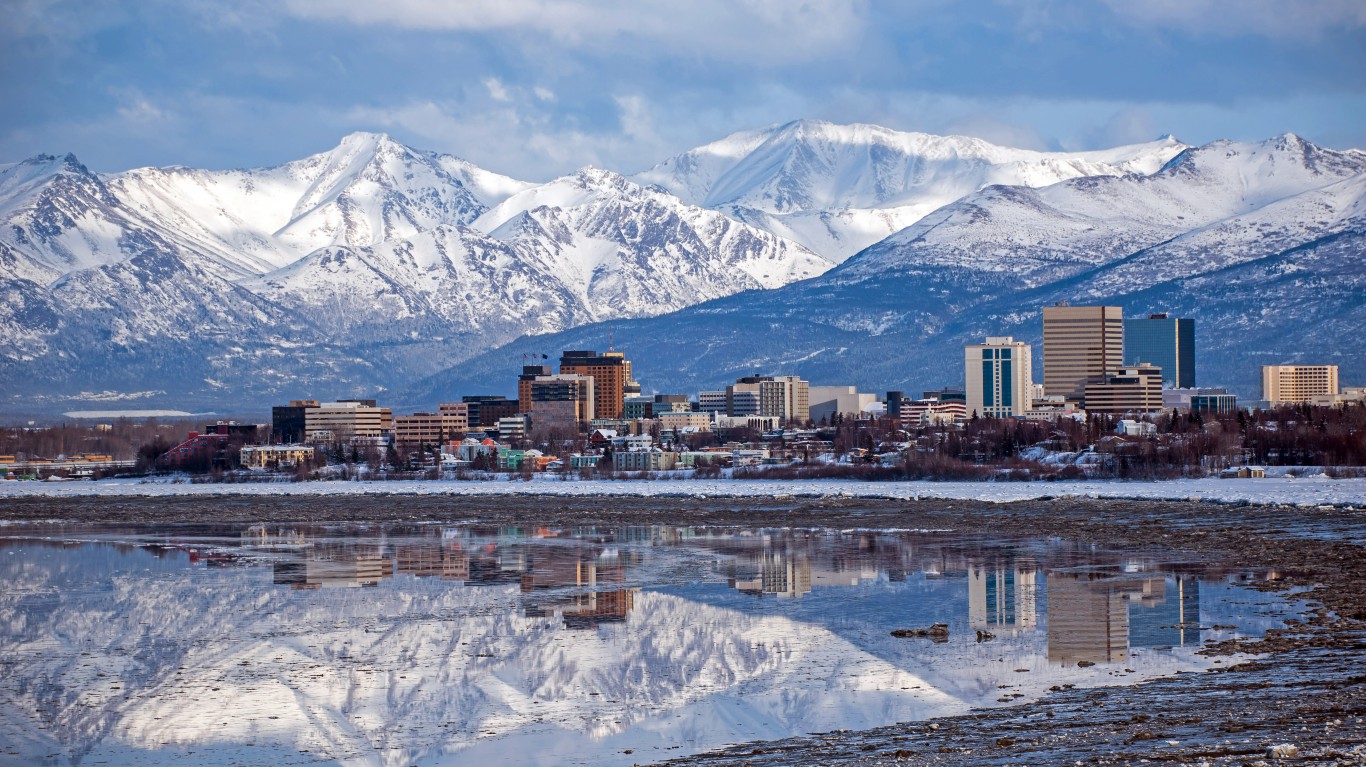
In much of the country, public pension funding has been one of the most persistent public policy problems. For years, state governments have failed to make necessary investments in their retirement system, resulting in funding gaps that increasingly present a looming reckoning for taxpayers.
According to a recent report published by The Pew Charitable Trusts, a public policy think tank, many states are now taking earnest measures to reduce their pension funding gap. These measures include increased contributions, cost reduction strategies, and more sophisticated pension management tools. States have also benefited from once-in-a-generation investment returns following the COVID-19 market crash in March 2020.
Still, based on 2019 data, the most recent year of available comprehensive data, only two states in the country have funding for 100% of their pension obligations. Meanwhile, just over half of all states have a funding shortfall of 25% or more.
Using pension funding data from The Pew Charitable Trusts, 24/7 Wall St. ranked the pension crisis in each state.
In contrast to 401(k) retirement plans, which have largely supplanted pensions in the private sector, pensions promise a specified monthly income to retirees for the rest of their life. Under this system, the burden of risk falls on the employer. Public sector workers, such as firefighters, police officers, and teachers, account for a considerable share of the workforce in parts of the country — and for many of them, pensions are critical to financial security throughout retirement. Here is a look at the states that pay teachers the least.
Click here to see every state’s pension crisis ranked
Click here to read our detailed methodology

50. Wisconsin
> Pension obligations funded: 103.0%
> Pension assets: $112.1 billion (6th highest)
> Pension liabilities: $108.9 billion (11th highest)
> State government workers: 3.2% of workforce — 9th lowest (89,800 total)
Wisconsin is one of only two states with pension assets that outweigh pension liabilities. The state has $3.2 billion more than it needs to cover what it owes in public employee pensions.
Wisconsin’s pension assets not only fully cover liabilities, but also generate solid investment income. In the fiscal year ending in June 2021, the Wisconsin Retirement System generated a 28% return.
[in-text-ad]

49. South Dakota
> Pension obligations funded: 100.1%
> Pension assets: $12.5 billion (8th lowest)
> Pension liabilities: $12.5 billion (6th lowest)
> State government workers: 4.1% of workforce — 22nd lowest (17,300 total)
Along with Wisconsin, South Dakota is one of only two states where its pension assets exceed its liabilities. The state has $10.6 million more in its pension fund than it needs to fully pay its obligations.
South Dakota has reduced the expected rate of return on its pension assets in recent years, from 7.75% to 7.25% in 2012, and then to 6.5% in 2017. Still, benefiting from strong stock market performance, the state’s retirement system reported 22% returns in fiscal 2021.

48. Tennessee
> Pension obligations funded: 98.2%
> Pension assets: $41.1 billion (23rd highest)
> Pension liabilities: $41.8 billion (20th lowest)
> State government workers: 3.2% of workforce — 8th lowest (95,500 total)
Tennessee has assets to cover over 98% of its $41.8 billion pension liabilities — the smallest relative funding gap of any state in the country. If no further funds were added to Tennessee’s pension system, it could continue to meet its payment obligations for another 18.3 years, a longer period than all but five other states.
In recently filed SEC documents, the Tennessee Department of Treasury, which manages retirement system funding, increased its holdings in tobacco giant Philip Morris while reducing its stakes in General Electric and pharmaceutical company Eli Lilly.

47. Washington
> Pension obligations funded: 96.3%
> Pension assets: $100.9 billion (8th highest)
> Pension liabilities: $104.8 billion (13th highest)
> State government workers: 4.3% of workforce — 24th highest (142,700 total)
Washington is one of only five states with a pension fund deficit of less than 5%. The state has pension liabilities totalling $104.8 billion and enough assets to cover all but $3.8 billion of that amount.
States with better funded retirement systems going into the COVID-19 pandemic had more to lose during the March 2020 market crash. Partially as a result, according to some estimates, Washington’s pension funded ratio could drop by nearly 10 percentage points between 2019, the most recent year of available data, and 2020. Gains in more recent months have likely offset these losses, however.
[in-text-ad-2]

46. New York
> Pension obligations funded: 96.1%
> Pension assets: $215.2 billion (2nd highest)
> Pension liabilities: $223.9 billion (4th highest)
> State government workers: 2.9% of workforce — 5th lowest (254,600 total)
New York has the fourth largest public retirement system of any state, with $223.9 billion in obligations. It also has one of the best funded retirement systems in the country, with $215.2 billion in assets, the second most assets of any state. Without any additional revenue, New York could continue paying public employee pensions for another 16.6 years with its current assets.
With a 96.1% funding ratio, New York has the best funded state pension system in the Northeast. Meanwhile, neighboring Connecticut and New Jersey have funding ratios of less than 45%.

45. Idaho
> Pension obligations funded: 94.6%
> Pension assets: $17.7 billion (14th lowest)
> Pension liabilities: $18.8 billion (11th lowest)
> State government workers: 4.0% of workforce — 21st lowest (30,100 total)
Idaho has $18.8 billion in pension liabilities against $17.7 billion in assets — a 94.6% funding ratio that ranks among the best in the country.
The Public Employee Retirement System of Idaho has been managed by CIO Bob Maynard for nearly three decades. When Maynard took the position, the state pension funding ratio was among the worst in the country, at only 62%. Manyard is slated to retire in September 2022.
[in-text-ad]

44. Nebraska
> Pension obligations funded: 93.1%
> Pension assets: $15.2 billion (10th lowest)
> Pension liabilities: $16.3 billion (8th lowest)
> State government workers: 4.3% of workforce — 25th highest (42,500 total)
Nebraska is one of only eight states with funding for over 90% of its public pension obligations. The state has $15.2 billion in assets in its pension fund against $16.3 billion in liabilities.
Soon, Nebraska’s liabilities will grow considerably. State lawmakers recently voted to assume the $1 billion in pension liabilities of the Omaha Public School System, overriding a veto by Gov. Pete Ricketts. The local pension is grossly underfunded following mismanagement leading up to the 2008 recession.

43. Utah
> Pension obligations funded: 91.7%
> Pension assets: $35.2 billion (25th lowest)
> Pension liabilities: $38.4 billion (17th lowest)
> State government workers: 5.3% of workforce — 10th highest (81,200 total)
Utah has a total of $35.2 billion in assets in its public employee pension fund, enough to cover 91.7% of its obligations. Public employee pension plans that are either partially or entirely under the state’s purview include the Judges Retirement System, Public Safety Retirement System, and Firefighters Retirement System, each of which is at least 80% funded.
At current levels, without any additional investments, Utah’s retirement system could meet its obligations for nearly another 20 years.

42. North Carolina
> Pension obligations funded: 88.4%
> Pension assets: $101.4 billion (7th highest)
> Pension liabilities: $114.6 billion (10th highest)
> State government workers: 4.5% of workforce — 20th highest (196,100 total)
With nearly 200,000 state employees, North Carolina has one of the largest public sector work forces in the country. It also has one of the best funded public pension plans of any state, with funds to cover 88.4% of its $114.6 billion in liabilities.
Public employee pension plans that are either partially or entirely under the state’s purview include the Consolidated Judicial Retirement System, Firefighter’s and Rescue Squad Workers’ Pension Fund, and the Legislative Retirement System, each of which is at least 87% funded.
[in-text-ad-2]

41. Iowa
> Pension obligations funded: 85.4%
> Pension assets: $34.8 billion (24th lowest)
> Pension liabilities: $40.7 billion (18th lowest)
> State government workers: 4.5% of workforce — 21st highest (67,100 total)
Iowa is one of only 10 states with funding for at least 85% of its pension obligations. The state has a total of $34.8 billion in assets in its pension fund against a total of $40.7 billion in liabilities. At current levels, without any additional investments, Iowa’s retirement system could meet its obligations for another 15 years.
The Iowa Public Employees’ Retirement System fund reported a net return of 29.6% in fiscal 2021, exceeding its policy benchmark of 28.8%.

40. Maine
> Pension obligations funded: 84.3%
> Pension assets: $15.1 billion (9th lowest)
> Pension liabilities: $17.9 billion (10th lowest)
> State government workers: 4.1% of workforce — 24th lowest (24,600 total)
With $15.1 billion in assets against $17.9 billion in pension obligations, Maine’s 84.3% funding ratio is the second highest in the Northeast, trailing only New York, and 11th highest among all states.
Some 30.5% of Maine’s pension assets — the largest share — are invested in public equity and less than half a percent is in cash. However, investment returns were lower than expected this year, yielding returns of 26.5% in the fiscal year ended June 2021, trailing the fund’s 27.4% benchmark.
[in-text-ad]

39. West Virginia
> Pension obligations funded: 83.4%
> Pension assets: $15.9 billion (12th lowest)
> Pension liabilities: $19.1 billion (12th lowest)
> State government workers: 7.0% of workforce — 4th highest (46,900 total)
West Virginia has the 12th best pension funding ratio among states, with assets to cover 83.4% of its $19.1 billion in pension obligations.
There are about 46,900 state government workers in West Virginia, comprising 7% of the state’s total workforce, the fourth largest share among states. At current levels, without any additional investments, West Virginia’s public retirement system could meet its obligations for nearly another 12 years.

38. Delaware
> Pension obligations funded: 83.4%
> Pension assets: $10.2 billion (6th lowest)
> Pension liabilities: $12.2 billion (5th lowest)
> State government workers: 7.3% of workforce — 3rd highest (32,200 total)
State workers account for a disproportionately large share of the workforce in Delaware. There are 32,200 workers in Delaware employed by the state, equal to 7.3% of the workforce, the third largest share in the country.
Delaware is relatively well-positioned financially to pay those workers’ pensions. The state has $10.2 billion in assets against $12.2 billion in liabilities, an 83.4% funding ratio. However, pensions for teachers in the state are not automatically adjusted for cost of living increases. As inflation is on the rise nationwide, pension recipients in Delaware are feeling the pinch as they have not received a permanent increase in payments in six years.

37. Minnesota
> Pension obligations funded: 82.2%
> Pension assets: $70.8 billion (14th highest)
> Pension liabilities: $86.1 billion (17th highest)
> State government workers: 3.6% of workforce — 14th lowest (98,900 total)
Minnesota is better positioned than most states to meet its public employee pension obligations. The state has $70.8 billion in assets against $86.1 billion in obligations — an 82.2% funding ratio. At current levels, without any additional investments, Minnesota’s public retirement system could meet its obligations for nearly another 14 years.
Public employee pension plans that are either partially or entirely under the state’s purview include the State Employees Retirement Fund, Correctional Employees Retirement Fund, and the Legislators Retirement Fund.
[in-text-ad-2]

36. Oklahoma
> Pension obligations funded: 80.7%
> Pension assets: $33.2 billion (23rd lowest)
> Pension liabilities: $41.1 billion (19th lowest)
> State government workers: 4.9% of workforce — 16th highest (79,700 total)
Oklahoma’s pension funding gap grew slightly over the year. Currently, the state has $41.1 billion in pension liabilities and $33.2 billion in assets, an 80.7% ratio. The year prior, the state had an 81.3% funding ratio.
Still, Oklahoma is better positioned than most other states. At current levels, without any additional investments, Oklahoma’s public retirement system could meet its obligations for another 13 years.

35. Oregon
> Pension obligations funded: 80.2%
> Pension assets: $70.2 billion (15th highest)
> Pension liabilities: $87.5 billion (16th highest)
> State government workers: 2.3% of workforce — the lowest (41,300 total)
Oregon is one of only 16 states with enough funds to cover over 80% of its slated pension obligations. As of 2019, the most recent year of available data, the state had $87.5 billion in pension liabilities and $70.2 billion in assets.
As is the case in much of the country, Oregon’s funding gap has widened, increasing from 17.9% in 2018 to its current level, at 19.8%.
[in-text-ad]

34. Ohio
> Pension obligations funded: 80.0%
> Pension assets: $168.4 billion (4th highest)
> Pension liabilities: $210.5 billion (5th highest)
> State government workers: 3.2% of workforce — 10th lowest (168,000 total)
Ohio has about $210.5 billion in pension obligations, and only about $168.4 billion in assets to cover them. Still, the 80% funding ratio in Ohio is better than in most other states.
Ohio has recently improved its ability to meet its pension obligations, as in the year prior, its funding ratio was only 75.8%. At current levels, without any additional investments, Ohio’s public retirement system could meet its obligations for nearly another 12 years.

33. Arkansas
> Pension obligations funded: 80.0%
> Pension assets: $28.6 billion (17th lowest)
> Pension liabilities: $35.7 billion (16th lowest)
> State government workers: 6.1% of workforce — 7th highest (76,200 total)
Arkansas is better positioned than most states to meet its public employee pension obligations. The state has $28.6 billion in assets against $35.7 billion in obligations — an 80% funding ratio, slightly lower than its 81.2% ratio the previous year.
The Arkansas Public Employees’ Retirement System fund reported a net return of 31.5% in fiscal 2021, exceeding its policy benchmark of 25.8%.

32. Georgia
> Pension obligations funded: 78.7%
> Pension assets: $95.6 billion (9th highest)
> Pension liabilities: $121.6 billion (9th highest)
> State government workers: 3.7% of workforce — 19th lowest (162,500 total)
Georgia’s pension funding gap grew slightly over the year. Currently, the state has $121.6 billion in pension liabilities and $95.6 billion in assets, a 78.7% funding ratio. The year prior, the state had an 80.1% funding ratio.
Still, Georgia is better positioned than most other states. At current levels, without any additional investments, the state’s public retirement system could meet its obligations for another 14 years.
[in-text-ad-2]

31. Florida
> Pension obligations funded: 78.2%
> Pension assets: $163.9 billion (5th highest)
> Pension liabilities: $209.5 billion (6th highest)
> State government workers: 2.9% of workforce — 4th lowest (246,400 total)
With nearly a quarter million public sector state employees, Florida has one of the largest state pension systems in the country. The state has a reported $209.5 billion in pension obligations, more than all but five other states. Currently, Florida’s pension assets total $163.9 billion, or 78.2% of its total liabilities.
The Florida Retirement System fund reported a net return of 29.5% in the fiscal year ending June 2021, exceeding its policy benchmark of 26.3%.

30. Missouri
> Pension obligations funded: 77.8%
> Pension assets: $59.9 billion (17th highest)
> Pension liabilities: $77.0 billion (19th highest)
> State government workers: 3.6% of workforce — 16th lowest (100,200 total)
With $59.9 billion in assets against $77.0 billion in pension obligations, Missouri’s 77.8% funding ratio is unchanged from the previous year. With current funding levels, without any additional investments, Missouri’s public retirement system could meet its obligations for another 13.5 years.
The Missouri State Employees’ Retirement System fund reported a net return of 26.4% in the fiscal year ending in June 2021, exceeding its policy benchmark of 25.2%.
[in-text-ad]

29. Virginia
> Pension obligations funded: 77.2%
> Pension assets: $79.8 billion (13th highest)
> Pension liabilities: $103.3 billion (14th highest)
> State government workers: 4.1% of workforce — 23rd lowest (157,300 total)
Virginia’s public pension fund has $79.8 billion in assets, well shy of its $103.3 billion in obligations. Still, with a 77.2% funding ratio, Virginia ranks in the top half of all states in pension funding.
Recently, the Virginia Retirement System approved real estate investments totaling $413.5 million. Meanwhile, other, local municipalities in the state are opting for less traditional investments. The Fairfax County Police Officers Retirement System and Fairfax County Employees’ Retirement System are planning to invest $50 million in a cryptocurrency fund. Board approval of the investment is pending.

28. Nevada
> Pension obligations funded: 76.5%
> Pension assets: $44.3 billion (22nd highest)
> Pension liabilities: $57.9 billion (24th highest)
> State government workers: 3.2% of workforce — 7th lowest (40,200 total)
Nevada has $57.9 billion in liabilities in its public pension system, and only $44.3 billion to cover those expenses. Nevada’s 76.5% pension funding ratio ranks close to the middle of all states.
Nevada’s most recent pension funding ratio is a slight improvement from one year prior, when the ratio stood at 75.3%. More recently, the state’s assets have been generating more revenue than expected through investments. The Nevada Public Employees’ Retirement System reported a return of 27.3% in fiscal 2021, outperforming the 25.6% benchmark.

27. Wyoming
> Pension obligations funded: 76.5%
> Pension assets: $9.0 billion (4th lowest)
> Pension liabilities: $11.8 billion (3rd lowest)
> State government workers: 5.0% of workforce — 13th highest (13,600 total)
Just under half of all states have a pension funding ratio above 75%, and Wyoming is one of them. The state has $11.8 billion in liabilities in its public pension system, and only $9.0 billion to cover those expenses, a 76.5% funding ratio.
Wyoming’s financial position with regard to public employee pensions has improved markedly over the year, climbing 8 percentage points from a 68.5% funding ratio to its current level — which, even without any further contributions, could continue to meet its payment obligations for another 13 years.
[in-text-ad-2]

26. Montana
> Pension obligations funded: 72.5%
> Pension assets: $11.9 billion (7th lowest)
> Pension liabilities: $16.4 billion (9th lowest)
> State government workers: 5.8% of workforce — 9th highest (27,400 total)
Montana is one of 26 states to not have funding for over 25% of its pension obligations. Montana’s public pension fund has $11.9 billion in assets, well shy of its $16.4 billion in obligations — a 72.5% funding ratio.
Unlike many other states, Montana’s investments of pension assets are underperforming. The Montana Board of Investments reported a 28.1% net return in fiscal 2021 on its consolidated pension pool, below the 29.7% benchmark.

25. California
> Pension obligations funded: 71.9%
> Pension assets: $474.3 billion (the highest)
> Pension liabilities: $659.4 billion (the highest)
> State government workers: 3.2% of workforce — 11th lowest (521,600 total)
California’s pension funded ratio of 71.9% is close to the median among all states. California is the only state with over half a million state government employees. Partially as a result, its $659.4 billion in pension obligations is also far and away the most of any state — more than double the $270.7 billion in Texas, which has the second largest obligation amount of any state. Additionally, despite having a middling funding ratio, California’s pension assets of $474.3 are also more than double that of any other state.
A recently published internal audit report of the California Public Employees’ Retirement System found that the pension fund has not been sufficiently tracking retiree deaths — a shortcoming that has resulted in nearly $42 million in unrecovered overpayments.
[in-text-ad]

24. Maryland
> Pension obligations funded: 71.6%
> Pension assets: $54.3 billion (19th highest)
> Pension liabilities: $75.8 billion (21st highest)
> State government workers: 4.2% of workforce — 25th lowest (108,100 total)
Over the most recent year of available data, Maryland’s pension funded ratio climbed from 70.4% to 71.6%, with $54.3 billion in pension assets against $75.8 billion in pension liabilities.
More recently, strong portfolio performance has altered Maryland’s pension funding strategy. Along with California and New York, Maryland is one of several states to lower its annual investment return targets in a move that will reduce the likelihood of taxpayers having to make up any shortfalls.

23. Kansas
> Pension obligations funded: 69.9%
> Pension assets: $20.6 billion (15th lowest)
> Pension liabilities: $29.5 billion (14th lowest)
> State government workers: 3.7% of workforce — 20th lowest (50,700 total)
Kansas is one of 23 states with funding for less than 70% of its total pension obligations. The state has $29.5 billion in liabilities in its public pension system, and only $20.6 billion to cover those expenses, a 69.9% funding ratio.
Like many other states, Kansas’ pension assets benefited tremendously from the stock market boom following the COVID-19 crash. The Kansas Public Employees Retirement System reported a 26.3% rate of return for fiscal 2021, the fund’s third highest annual return in nearly half a century.

22. North Dakota
> Pension obligations funded: 69.8%
> Pension assets: $5.9 billion (2nd lowest)
> Pension liabilities: $8.4 billion (2nd lowest)
> State government workers: 5.2% of workforce — 11th highest (21,400 total)
North Dakota has about $8.4 billion in pension obligations, and only about $5.9 billion in assets to cover them. The 69.8% funding ratio in North Dakota is lower than in most other states.
North Dakota has recently improved its ability to meet its pension obligations as in the year prior, its funding ratio was only 65.2%. At current levels, without any additional investments, North Dakota’s public retirement system could meet its obligations for nearly another 14 years.
[in-text-ad-2]

21. Alabama
> Pension obligations funded: 69.4%
> Pension assets: $38.5 billion (24th highest)
> Pension liabilities: $55.5 billion (25th highest)
> State government workers: 5.9% of workforce — 8th highest (117,000 total)
Alabama’s pension funding ratio of 69.4% is the 21st lowest among states. Alabama has $55.5 billion in public pension liabilities and only $38.5 billion in assets. By far the largest component of Alabama’s public pension fund is the Teacher’s Retirement System, which accounts for over half of all asset value.
In recently filed SEC documents, Retirement Systems of Alabama increased its holdings in tobacco giant Altria Group and industrial machinery manufacturer Honeywell International, while reducing its stakes in Disney.

20. Texas
> Pension obligations funded: 69.0%
> Pension assets: $186.8 billion (3rd highest)
> Pension liabilities: $270.7 billion (2nd highest)
> State government workers: 3.5% of workforce — 12th lowest (426,400 total)
Texas has the second largest state-level public sector workforce in the country, with about 426,400 personnel. As a result, it also has a large public pension obligation of about $270.7 billion. Texas only has about $186.8 billion in assets against those liabilities, however — a 69.0% funding level, lower than most other states.
Recently, the Texas House moved a bill forward with bipartisan support that would pay retired teachers and school staff a one-time lump sum of $2,400 to help offset cost of living increases not addressed in pension payouts. Retired teachers in the state have not received a cost of living adjustment or payment since 2013.
[in-text-ad]

19. Indiana
> Pension obligations funded: 68.6%
> Pension assets: $30.8 billion (20th lowest)
> Pension liabilities: $44.9 billion (22nd lowest)
> State government workers: 3.6% of workforce — 18th lowest (108,900 total)
With $30.8 billion in assets against $44.9 billion in liabilities, Indiana has funding for only 68.6% of its pension liabilities, the 19th lowest ratio among states. Still, the state’s funding ratio is an improvement from the previous year, when there was funding for only 66.5% of pension liabilities.
Like many other states, Indiana’s pension assets benefited tremendously from the stock market boom following the COVID-19 crash. The Indiana Public Retirement System reported a 23.1% rate of return for fiscal 2021, surpassing the 22.4% benchmark.

18. Alaska
> Pension obligations funded: 67.4%
> Pension assets: $15.2 billion (11th lowest)
> Pension liabilities: $22.6 billion (13th lowest)
> State government workers: 7.5% of workforce — 2nd highest (22,500 total)
State-level public sector employees account for a far larger than average share of all workers in Alaska. The 22,500 state employees in Alaska make up 7.5% of the total workforce, the second largest share among all states — and Alaska is not especially well positioned to meet its obligations for its workers’ retirements
Alaska’s pension liabilities total $22.6 billion, yet the state has only $15.2 billion in pension assets — a 67.4% funding ratio that ranks as the 18th lowest among states.

17. New Mexico
> Pension obligations funded: 67.3%
> Pension assets: $29.2 billion (19th lowest)
> Pension liabilities: $43.4 billion (21st lowest)
> State government workers: 6.7% of workforce — 5th highest (53,700 total)
With $29.2 billion in assets against $43.4 billion in liabilities, New Mexico has funding for only 67.3% of its pension liabilities, less than most other states. Still, the state’s funding ratio is an improvement from the previous year, when there was funding for only 61.0% of pension liabilities.
Like many other states, New Mexico’s pension assets benefited tremendously from the stock market boom following the COVID-19 crash. The New Mexico Educational Retirement Board reported a 28.8% rate of return for fiscal 2021, surpassing the 24.3% benchmark.
[in-text-ad-2]

16. Louisiana
> Pension obligations funded: 66.9%
> Pension assets: $36.8 billion (25th highest)
> Pension liabilities: $54.9 billion (25th lowest)
> State government workers: 4.7% of workforce — 18th highest (86,800 total)
Louisiana’s state pension system has liabilities totalling $54.9 billion. Yet, the state has only $36.8 billion in pension assets, enough to cover only about two-thirds of its obligations to retired state workers.
Due to a market boom in the wake of the COVID-19 crash, Louisiana’s pension system will likely be in better shape in coming years. The state’s Teachers’ Retirement System, by far the largest public pension fund in Louisiana, reported returns of 35.7% in fiscal 2021, surpassing the 27.7% benchmark. Over half of that fund is invested in alternative assets, real estate, and domestic equities.

15. Colorado
> Pension obligations funded: 66.5%
> Pension assets: $51.8 billion (20th highest)
> Pension liabilities: $77.9 billion (18th highest)
> State government workers: 4.8% of workforce — 17th highest (126,600 total)
Colorado’s public employee pension system is underfunded to a greater degree than most other states. Pension liabilities in the state total $77.9 billion — yet at $51.8 billion, pension assets cover only about two-thirds of total obligations.
A recent audit of Colorado’s retirement system revealed biases in assumptions related to cash flow. Among them are underestimating the effect of employee withdrawal on liabilities and underestimating the pension costs of new entrants to the system. These resulted in the understating obligations to tune of about $500 million per year. Colorado lawmakers will work to address these and other issues to have a fully funded retirement system by the target date of 2048.
[in-text-ad]

14. New Hampshire
> Pension obligations funded: 65.5%
> Pension assets: $9.2 billion (5th lowest)
> Pension liabilities: $14.1 billion (7th lowest)
> State government workers: 3.5% of workforce — 13th lowest (22,400 total)
New Hampshire is one of 15 states with funding for less than two-thirds of its pension obligations. The state’s pension assets are nearly $5 billion shy of its $14.1 billion in liabilities.
Recent pay raises for Concord police officers that extend beyond contractual salary increases by nearly $1 million will soon add to liabilities for the state’s retirement system. Responsibility for closing the funding gap will fall to Jan Goodwin, who took over as executive director of the New Hampshire Retirement System in April 2021. Goodwin left her job as executive director of the New Mexico Educational Retirement Board to accept the position.

13. Arizona
> Pension obligations funded: 65.2%
> Pension assets: $49.9 billion (21st highest)
> Pension liabilities: $76.6 billion (20th highest)
> State government workers: 3.2% of workforce — 6th lowest (89,800 total)
With $49.9 billion in assets against $76.6 billion in liabilities, Arizona has funding for only 65.2% of its pension liabilities, less than all but a dozen other states. Arizona’s pension fund footing worsened slightly in the most recent year of available data, falling from a 65.5% funding ratio in 2018.
Many local municipalities in Arizona are struggling to finance their public retirement funds as well, taking advantage of low borrowing costs and selling debt to pay retirees. In June, the town of Douglas sold nearly $39 million in pension obligation securities, and the city of Glendale issued $253 million in pension bonds in June.

12. Vermont
> Pension obligations funded: 63.7%
> Pension assets: $4.5 billion (the lowest)
> Pension liabilities: $7.1 billion (the lowest)
> State government workers: 6.2% of workforce — 6th highest (17,800 total)
Vermont is up against a $2.6 billion gap in pension funding, the smallest of any state in nominal terms. However, Vermont also has a relatively small public sector workforce, and with only $4.5 billion in assets against $7.1 billion in liabilities, it has the 12th worst pension funding ratio among states, at 63.7%. Vermont’s pension fund footing worsened slightly during the year, falling half a percentage point from a 64.2% funding ratio in 2018.
This past Labor Day, lawmakers in Vermont announced plans for a legislative agenda that will include stabilization and expansion of the state’s pension system.
[in-text-ad-2]

11. Mississippi
> Pension obligations funded: 61.7%
> Pension assets: $28.6 billion (18th lowest)
> Pension liabilities: $46.4 billion (23rd lowest)
> State government workers: 5.2% of workforce — 12th highest (57,400 total)
Mississippi’s state pension system has liabilities totalling $46.4 billion. Yet, the state has only $28.6 billion in pension assets, enough to cover only about 62% of its obligations to retired state workers. Mississippi is one of only 10 states where, at current levels, pension assets could continue to pay benefits for less than 10 years.
Due to a strong rate of return of 33% in the last fiscal year, the board of Mississippi’s Public Employee Retirement System voted not to increase contribution rates — the amount employers pay into the pension fund — for state or local governments.

10. Michigan
> Pension obligations funded: 61.1%
> Pension assets: $65.0 billion (16th highest)
> Pension liabilities: $106.4 billion (12th highest)
> State government workers: 4.4% of workforce — 23rd highest (178,800 total)
Michigan pension funding ratio of 61.1% is one of the 10 worst among states. The state’s pension system has liabilities totalling $106.4 billion yet the state has only $65.0 billion in pension assets. Michigan’s pension fund footing worsened slightly during the most recent year of data, falling just over 2 percentage points from a 63.2% funding ratio in 2018.
Some local municipalities in Michigan are struggling to finance their public retirement funds as well, taking advantage of low borrowing costs and selling debt to pay retirees. In August, Grand Traverse County moved forward with a plan to fund $40 million pension debt by issuing bonds.
[in-text-ad]

9. Massachusetts
> Pension obligations funded: 59.4%
> Pension assets: $58.3 billion (18th highest)
> Pension liabilities: $98.1 billion (15th highest)
> State government workers: 3.6% of workforce — 17th lowest (122,600 total)
Massachusetts is one of only nine states with a pension funding ratio below 60%. The state has $58.3 billion in pension assets, $39.8 billion shy of its $98.1 billion in total liabilities. Massachusetts’ pension fund footing worsened slightly during the year, falling from a 60.6% funding ratio in 2018 to its current level of 59.4%.
Currently, a majority of lawmakers in Massachusetts are supporting a bill that will pay a retirement bonus to state employees who worked outside of the home from the beginning of the COVID-19 pandemic through the end of 2020.

8. Pennsylvania
> Pension obligations funded: 58.0%
> Pension assets: $89.8 billion (11th highest)
> Pension liabilities: $154.8 billion (8th highest)
> State government workers: 2.7% of workforce — 3rd lowest (148,600 total)
With $89.8 billion in assets against $154.8 billion in liabilities, Pennsylvania has funding for only 58.0% of its pension liabilities, the eighth lowest ratio among states. Still, the state’s funding ratio is an improvement from the previous year, when there was funding for only 54.8% of pension liabilities.
Lack of sufficient funding is having a meaningful impact on the financial security of public sector retirees in the state. Funding shortages have meant that the Public School Employees’ Retirement System and the State Employees’ Retirement System in Pennsylvania have not had a cost of living adjustment since 2002.

7. South Carolina
> Pension obligations funded: 55.4%
> Pension assets: $32.3 billion (22nd lowest)
> Pension liabilities: $58.3 billion (23rd highest)
> State government workers: 5.0% of workforce — 14th highest (103,500 total)
South Carolina’s pension crisis is among the worst of any state, as the state faces a $26 billion funding gap. With $32.3 billion in assets against $58.3 billion in liabilities, South Carolina has funding for only 55.4% of its pension liabilities.
Though the state reported a 28.6% return on assets in fiscal 2021, a dramatic improvement from the 1.6% loss the previous year, structural problems remain. Some in the state are calling for raising the retirement age and shifting new public sector employees to a 401(k) style plan in order to remove the burden on taxpayers that the current funding gap presents.
[in-text-ad-2]

6. Hawaii
> Pension obligations funded: 54.9%
> Pension assets: $17.2 billion (13th lowest)
> Pension liabilities: $31.4 billion (15th lowest)
> State government workers: 12.0% of workforce — the highest (67,000 total)
Only five states have a worse pension problem than Hawaii. Hawaii’s state pension system has liabilities totalling $31.4 billion, yet only $17.2 billion in pension assets — enough to cover only about 55% of its obligations to retired state workers.
Like many states, Hawaii’s pension fund grew rapidly in recent months. In the first three quarters of fiscal 2021, Hawaii’s Employees’ Retirement System fund had a return rate of 19.5%, nearly the strongest performance over the comparable period in a decade.

5. Rhode Island
> Pension obligations funded: 54.5%
> Pension assets: $6.6 billion (3rd lowest)
> Pension liabilities: $12.1 billion (4th lowest)
> State government workers: 4.4% of workforce — 22nd highest (20,400 total)
Rhode Island has funding for only 54.5% of its $12.1 billion pension liabilities, the fifth worst pension funding ratio among states. With only $6.6 billion in pension assets, Rhode Island is also one of only five states where, at current levels, pension assets could continue to pay benefits for less than eight years.
Rhode Island’s funding ratio has changed little from the previous year, when it stood at 54.2%.
[in-text-ad]

4. Kentucky
> Pension obligations funded: 44.6%
> Pension assets: $24.0 billion (16th lowest)
> Pension liabilities: $53.7 billion (24th lowest)
> State government workers: 4.9% of workforce — 15th highest (90,800 total)
Kentucky is one of only four states with funding for less than half of its pension obligations. The state has only $24.0 billion in pension assets against $53.7 billion in liabilities — a 44.6% funding ratio. Kentucky is also one of only five states where, at current levels, pension assets could continue to pay benefits for less than eight years.
Due to a market boom in the wake of the COVID-19 crash, Kentucky’s pension system will likely be in better shape in coming years. The state’s Teachers’ Retirement System, by far the largest public pension fund in Kentucky, reported record returns of 29.9% in the fiscal year ended in June 2021.

3. Connecticut
> Pension obligations funded: 44.4%
> Pension assets: $32.0 billion (21st lowest)
> Pension liabilities: $72.1 billion (22nd highest)
> State government workers: 4.5% of workforce — 19th highest (71,000 total)
Connecticut’s public pension system is the most poorly funded of any state in New England and the third most underfunded nationwide. Connecticut has funding for only 44.4% of its $72.1 billion pension liabilities. With only $32.0 billion in pension assets, Connecticut is also one of only five states where, at current levels, pension assets could continue to pay benefits for less than eight years.
Connecticut’s Teachers’ Retirement Fund, the largest component of its pension system, reported 24.3% in returns in the fiscal year ended June 2021, underperforming its benchmark by 8 percentage points. Meanwhile, over the same period, the State Employees’ Retirement Fund, the second largest component, generated similar returns, which were in line with its benchmark.

2. New Jersey
> Pension obligations funded: 39.7%
> Pension assets: $82.3 billion (12th highest)
> Pension liabilities: $207.1 billion (7th highest)
> State government workers: 3.6% of workforce — 15th lowest (138,700 total)
New Jersey is one of only two states with funding for less than 40% of its pension obligations. The state has only $82.3 billion in pension assets against $207.1 billion in liabilities — a 39.7% funding ratio. The state’s most recently reported funding ratio is an improvement from the 38.4% ratio the previous year.
In recent years, New Jersey has increased its annual pension contribution. The ramp up began under former Gov. Chris Christie and has continued under Gov. Phil Murphy.
[in-text-ad-2]

1. Illinois
> Pension obligations funded: 38.9%
> Pension assets: $92.6 billion (10th highest)
> Pension liabilities: $237.9 billion (3rd highest)
> State government workers: 2.6% of workforce — 2nd lowest (147,000 total)
Illinois has the most underfunded pension system in the United States. Illinois’ state pension system has liabilities totalling $237.9 billion, yet only $92.6 billion in pension assets — enough to cover only 38.9% of its obligations to retired state workers.
One of the largest challenges Illinois faces in closing its $145.3 billion pension gap is the mandated cost of living adjustments. Retired state employees in Illinois receive a 3% annual cost of living increase, regardless of the actual inflation rate.
Methodology
To determine the pension crisis each state is facing, 24/7 Wall St. reviewed the pension funding ratio — a state’s total pension assets as a share of its pension liabilities — for 2019, the most recent year of available data. All data was compiled by the public policy nongovernmental organization, The Pew Charitable Trusts.
We also considered public-sector, state-level employment, both in raw numbers and as a share of overall employment, using data from the Bureau of Labor Statistics.
Is Your Money Earning the Best Possible Rate? (Sponsor)
Let’s face it: If your money is just sitting in a checking account, you’re losing value every single day. With most checking accounts offering little to no interest, the cash you worked so hard to save is gradually being eroded by inflation.
However, by moving that money into a high-yield savings account, you can put your cash to work, growing steadily with little to no effort on your part. In just a few clicks, you can set up a high-yield savings account and start earning interest immediately.
There are plenty of reputable banks and online platforms that offer competitive rates, and many of them come with zero fees and no minimum balance requirements. Click here to see if you’re earning the best possible rate on your money!
Thank you for reading! Have some feedback for us?
Contact the 24/7 Wall St. editorial team.
 24/7 Wall St.
24/7 Wall St. 24/7 Wall St.
24/7 Wall St. 24/7 Wall St.
24/7 Wall St. 24/7 Wall St.
24/7 Wall St. 24/7 Wall St.
24/7 Wall St.
